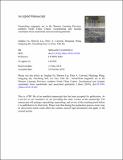Neoarchean magmatic arc in the Western Liaoning Province, northern North China Craton : geochemical and isotopic constraints from sanukitoids and associated granitoids
Abstract
The Neoarchean Western Liaoning basement terranes in the northern part of North China Craton chiefly consist of tholeiitic basalts in the north, TTG gneisses and metavolcanic rocks in the northwest, and K-rich granitoids in the southeast. In the southeastern zone, porphyritic monzodioritic-quartz monzodioritic-granodioritic-monzogranitic (MQGM) gneisses are the major lithological assemblage, and locally contain minor xenoliths of TTG gneisses. Based on the major mafic mineral phases, the porphyritic MQGM gneisses can be divided into amphibole-dominated and biotite-dominated groups. Zircon UPb isotopic dating indicates that the amphibole-dominated MQGM gneisses, biotite-dominated MQGM gneisses, and tonalitic gneiss xenolith were emplaced during 2546–2529 Ma, 2546–2531 Ma, and at 2563 Ma, respectively. The 2563 Ma tonalitic gneiss xenolith displays geochemical affinities to high-SiO2 adakites, and may be formed by the partial melting of descending oceanic slabs, with the melt contaminated by mantle peridotite. The amphibole-dominated MQGM gneisses are geochemically analogous to sanukitoids, and their magmatic precursors were formed by partial melting of lithospheric mantle, which was metasomatized by dehydration fluids and melts derived from subducted oceanic sediments and slabs. The magmatic precursors of the biotite-dominated MQGM gneisses were generated by the partial melting of medium-K to high-K mafic rocks at medium pressures. Integrated with previous studies on supracrustal sequences and granitoids in Western Liaoning Province, the Neoarchean lithological assemblages in the southeastern zone were most likely formed in an active continental margin setting.
Citation
Fu , J , Liu , S , Cawood , P A , Wang , M , Hu , F , Sun , G , Gao , L & Hu , Y 2018 , ' Neoarchean magmatic arc in the Western Liaoning Province, northern North China Craton : geochemical and isotopic constraints from sanukitoids and associated granitoids ' , Lithos , vol. In press . https://doi.org/10.1016/j.lithos.2018.10.024
Publication
Lithos
Status
Peer reviewed
ISSN
0024-4937Type
Journal article
Description
This study is financially supported by the National Natural Science Foundation of China (Grant Nos. 41530207, 41772188 and 41472165). Peter A. Cawood acknowledges support from Australian Research Council grant FL 160100168.Collections
Items in the St Andrews Research Repository are protected by copyright, with all rights reserved, unless otherwise indicated.

